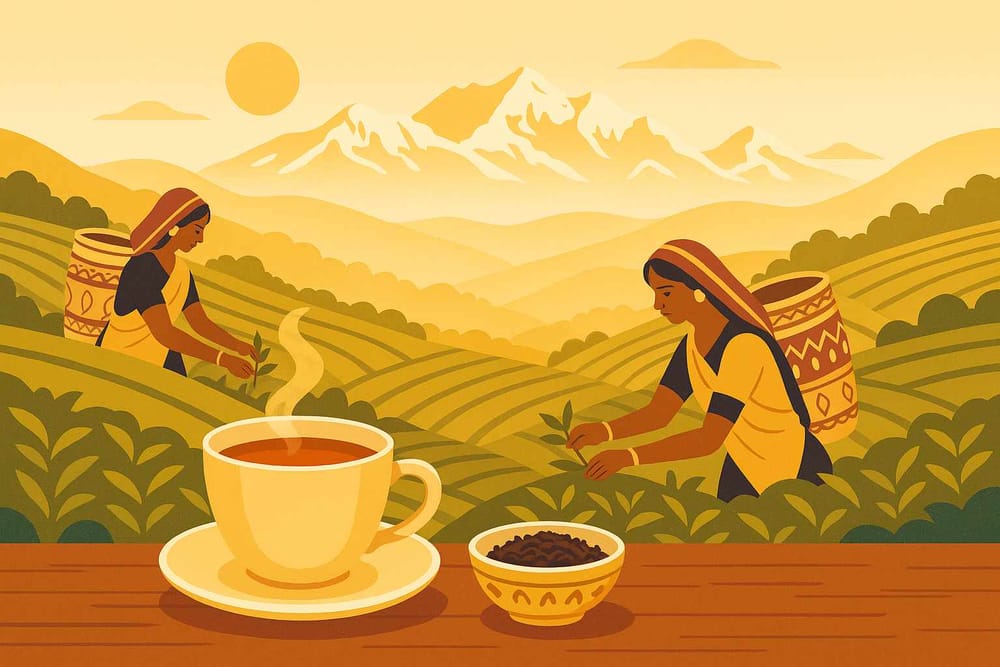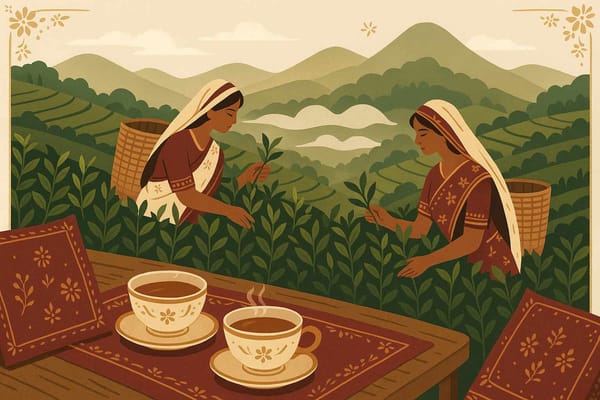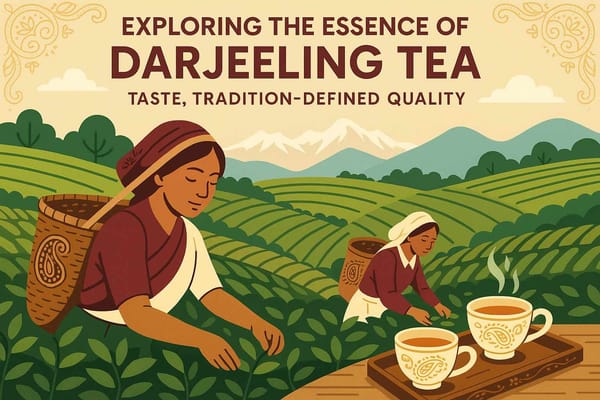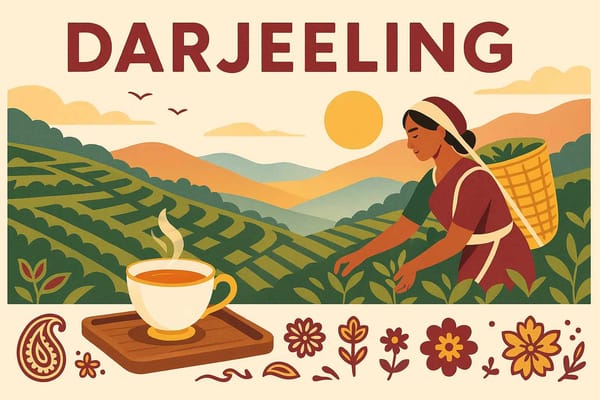
Exploring Darjeeling Tea-History and Flavors
Have you ever held a warm cup of tea, closed your eyes, and felt transported to another place? For me, a cup of authentic Darjeeling tea does just that. It’s not just a beverage; it's an experience. With every sip, you can almost feel the cool mist of the Himalayan foothills, hear the rustle of tea leaves, and sense the rich history that flows through its delicate flavour. This isn't just any chai; it's the story of India, brewed to perfection.
Often called the "Champagne of Teas," this title isn’t just a fancy marketing term. It’s a genuine tribute to its unmatched quality and the unique, grape-like ‘muscatel’ flavour that connoisseurs around the world cherish. Much like Champagne can only come from a specific region in France, true Darjeeling tea can only be grown in the specific tea gardens of the Darjeeling and Kalimpong districts of West Bengal. Let’s take a journey together to explore the heart and soul of this incredible Indian treasure.
The Story Behind the Golden Brew: A Journey Through Time
The tale of Darjeeling tea begins not with an ancient Indian tradition, but in the 1840s, during the British era. It started with a curious experiment by Dr. Archibald Campbell, a civil surgeon who planted some Chinese tea seeds in his garden. Little did he know that these tiny seeds would blossom into a global phenomenon. The cool climate and sloped terrain of Darjeeling turned out to be the perfect home for these plants.
Soon, the British recognised the potential, and commercial tea estates began to sprout up, transforming the quiet hills into bustling plantations. This journey, however, wasn't just built by the British; it was nurtured by the hardworking hands of countless workers from Nepal and Sikkim, mainly the Gorkha and Lepcha communities. They are the unsung heroes whose skill and dedication have shaped the legacy of this tea. From a colonial enterprise, Darjeeling tea has beautifully transitioned into a symbol of Indian pride. In 2004, it was rightfully granted the Geographical Indication (GI) tag, a special status that protects its authenticity and heritage from imitations.
From the Soil to Your Cup: The Magic of "Terroir" and Harvest
What gives Darjeeling tea its soul-stirring flavour? The secret lies in its unique "terroir"—a beautiful word that describes the combined effect of soil, climate, and altitude. The tea gardens, perched at heights between 600 and 2,000 meters, are blessed with cool mountain air, persistent mist, and rich, well-drained soil. This magical combination slows down the growth of the tea bushes, allowing the leaves to develop a complex and deeply aromatic character that you won't find anywhere else.
The harvest itself is a symphony of seasons, with each period, or "flush," offering a completely different experience.
- First Flush (Spring): Harvested between late February and mid-April, this is the most delicate and prized batch. It produces a light, golden liquor with a fresh, floral aroma and a hint of briskness. It truly feels like sipping the essence of springtime.
- Second Flush (Summer): Plucked from May to June, this is when the legendary 'muscatel' flavour comes alive. The tea is more full-bodied, with a rich amber colour and a sweet, fruity taste that reminds one of muscat grapes. This is the flush that truly earned Darjeeling its "Champagne of Teas" nickname.
- Monsoon Flush (Rainy Season): Gathered from July to September, this tea is stronger and bolder. While less complex than the other flushes, its earthy notes make it perfect for blending and for those who enjoy a more robust cup.
- Autumn Flush (Fall): The final harvest from October to November offers a beautiful balance. The liquor has a deeper colour and a smooth, mellow flavour with floral and fruity undertones, making it a comforting brew for cooler days.
The plucking process is an art form. Skilled pluckers, mostly women, meticulously hand-pick only the tender "two leaves and a bud." This precision ensures that only the finest leaves make it to your cup, preserving the premium quality that Darjeeling is famous for.
The Artistry in Every Leaf: Processing and Types
Once plucked, the leaves begin a carefully monitored transformation. They are withered, rolled, oxidized, and dried by artisans who have inherited this knowledge through generations. It is this human touch that elevates the tea from a simple agricultural product to a work of art. While Darjeeling is most famous for its black tea, the estates also produce other exquisite varieties.
- Green Tea: With a fresh, grassy flavour and a light green hue, this tea is less oxidized, preserving many of its natural antioxidants.
- White Tea: The most minimally processed of all, made from young buds and leaves. It has a delicate, slightly sweet flavour with a velvety texture.
- Oolong Tea: This partially fermented tea sits beautifully between green and black teas, offering a complex, aromatic cup with lovely floral and roasted notes.
For the truest experience, it's often recommended to enjoy Darjeeling tea without milk or sugar. This allows its delicate and complex flavours to shine through without being masked. It’s also packed with antioxidants, which are known to boost immunity and help reduce stress—a perfect, healthy indulgence.
Embracing a Living Legacy
Darjeeling tea is more than just a morning ritual; it's a living heritage. It’s a story of nature’s bounty, human skill, and a deep connection to the land. As you savour your next cup, take a moment to appreciate its incredible journey—from the misty slopes of the Himalayas to the warmth of your hands. It’s a timeless experience that connects us to our roots and reminds us of the simple, profound joys of life.
Pairing this exquisite tea with our traditional Indian sweets can elevate the experience even further. The floral notes of a First Flush or the fruity depth of an Autumn Flush complement the richness of our festive mithais beautifully. You can discover more about these wonderful pairings by exploring the delightful world of traditional sweets and dishes that grace our celebrations.
A Note from Bhaktilipi
At Bhaktilipi, we believe in connecting you with the heart of Indian culture and tradition. We bring timeless stories and devotional literature to you in a way that feels both authentic and accessible. Our goal is to help you rediscover the beauty of our rituals and the deep wisdom they hold, making them a meaningful part of your modern life.
To continue this journey of discovery, we invite you to explore our platform. Stay connected with us and receive more such enriching content by subscribing to our newsletter, and following us on Facebook, Instagram, and our growing YouTube community.
A passionate group of people dedicated to preserving India's knowledge of Dharma, Karma, and Bhakti for ourselves and the world 🙏.
Comments
Related in

Exploring the Unique Flavors of Darjeeling Tea: A 2025 Guide
There's a certain magic that unfolds when you hold a warm cup of tea, especially when it’s from the misty slopes of Darjeeling. It’s more than just a drink; it feels like a heartfelt conversation with the mountains themselves. For many of us in India, a

Exploring the Essence of Darjeeling Tea: Taste Tradition-Define Quality
Have you ever held a warm cup, closed your eyes, and felt transported to another place? For me, that place is the misty, rolling hills of Darjeeling. There's a certain magic captured in a cup of its famous tea—a story of the mountains, the crisp air, and

The Rich Aroma: Darjeeling Tea Delivers a World of Flavor
I still remember the scent. The soft pitter-patter of monsoon rain outside, a cool breeze wafting through the veranda, and my grandmother carefully brewing a pot of tea. It wasn’t just any chai; it was her special Darjeeling tea. The aroma that filled our home was delicate, almost like
